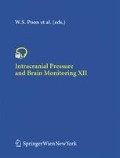Summary
The aim of this open, descriptive and prospective study was to determine if the new monitoring parameter “continuous intracranial compliance (cICC)” decreases with age in patients with traumatic brain injury (TBI).
30 patients with severe and moderate TBI (Glasgow Coma Scale scorea ≤ 10) contributing to a European multicenter study, organized by the Brain-IT group, underwent computerized monitoring of blood pressure, intracranial pressure (ICP), cerebral perfusion pressure and cICC.
Regression analyses of individual median ICP and median cICC versus patients’ age revealed no significant dependency. Median cICC declined significantly with increasing ICP (when median ICP = 10, 20 and 30 mmHg, cICC = 0.64; 0.56 and 0.42 ml/mmHg respectively, p < 0.05). These three ICP groups were then subdivided according to age (0–20, 21–40, 41–60 and 61–80 years). Median cICC declined with age in both high ICP groups (median ICP = 20, 30 mmHg). Percentage cICC values below a set pathological threshold of lower than 0.05 ml/mmHg across the four age groups were 28% (0–20 yrs), 59% (21–40 yrs), 60% (41–60 yrs) and 70% (61–80 yrs) respectively.
The observed phenomenon of decreased intracranial volume challenge compensation with advancing age may contribute to the well-known fact of a worse outcome in elderly patients after TBI.
Access this chapter
Tax calculation will be finalised at checkout
Purchases are for personal use only
Preview
Unable to display preview. Download preview PDF.
References
Albeck MJ, Skak C, Nielsen PR, Olsen KS, Borgesen SE, Gjerris F (1998) Age dependency of resistance to cerebrospinal fluid outflow. J Neurosurg 89: 275–278
Baker SP, O’Neill B, Haddon W Jr, Long WB (1974) The Injury Severity Score: a method for describing patients with multiple injuries and evaluating emergency care. J Trauma 14: 187–196
Braakman R, Gelpke GJ, Habbema JD, Maas AI, Minderhoud JM (1980) Systematic selection of prognostic features in patients with severe head injury. Neurosurgery 6: 362–370
Brain Trauma Foundation, American Association of Neurological Surgeons, Joint Section on Neurotrauma and Critical Care (2000) Guidelines for the management of severe traumatic brain injury. J Neurotrauma 17: 453–553
Czosnyka M, Czosnyka ZH, Whitfield PC, Donovan T, Pickard JD (2001) Age dependence of cerebrospinal pressure-volume compensation in patients with hydrocephalus. J Neurosurg 94: 482–486
Kiening KL, Schoening WN, Lanksch WR, Unterberg AW (2002) Intracranial Compliance as bed-side monitoring in severely head-injured patients. Acta Neurochir [Suppl] 81: 177–180
Kiening KL, Schoening WN, Stover JF, Unterberg AW (2003) Continuous monitoring of intracranial compliance after severe head injury: relation to data quality, intracranial prerssure and brain tissue PO2. Br J Neurosurg 17: 340–346
Marshall LF, Marshall SB, Klauber MR, Van Berkum Clark M, Eisenberg H, Jane JA, Luerssen TG, Marmarou A, Foulkes MA (1992) The diagnosis of head injury requires a classification based on computed axial tomography. J Neurotrauma 9: S287–292
Maset AL, Marmarou A, Ward JD, Choi S, Lutz HA, Brooks D, Moulton RJ, DeSalles A, Muizelaar JP, Turner H, et al (1987) Pressure-volume index in head injury. J Neurosurg 67: 832–840
Miller JD, Leech P (1975) Effects of mannitol and steroid therapy on intracranial volume-pressure relationships in patients. J Neurosurg 42: 274–281
Miller JD, Pickard JD (1974) Intracranial volume pressure studies in patients with head injury. Injury 5: 265–268
Piper I, Dunn L, Contant C, Yau Y, Whittle I, Citerio G, Kiening K, Schoening W, Ng S, Poon W, Enblad P, Nilsson P (2000) Multi-centre assessment of the Spiegelberg compliance monitor: preliminary results. Acta Neurochir [Suppl] 76: 491–494
Piper IR, Spiegelberg A, Whittle I, Signorini D, Mascia L (1999) A comparative study of the Spiegelberg compliance device with a manual volume-injection method: a clinical evaluation in patients with hydrocephalus. Br J Neurosurg 13: 581–586
Signorini DF, Andrews PJ, Jones PA, Wardlaw JM, Miller JD (1999) Predicting survival using simple clinical variables: a case study in traumatic brain injury. J Neurol Neurosurg Psychiat 66: 20–25
Sullivan HG, Miller JD, Becker DP, Flora RE, Allen GA (1977) The physiological basis of intracranial pressure change with progressive epidural brain compression. An experimental evaluation in cats. J Neurosurg 47: 532–550
Uftring SJ, Chu D, Alperin N, Levin DN (2000) The mechanical state of intracranial tissues in elderly subjects studied by imaging CSF and brain pulsations. Magn Reson Imaging 18: 991–996
Yau Y, Piper I, Contant C, Citerio G, Kiening K, Enblad P, Nilsson P, Ng S, Wasserberg J, Kiefer M, Poon W, Dunn L, Whittle I (2002) Multi-centre assessment of the Spiegelberg compliance monitor: interim results. Acta Neurochir [Suppl] 81: 167–170
Yau YH, Piper IR, Clutton RE, Whittle IR (2000) Experimental evaluation of the Spiegelberg intracranial pressure and intracranial compliance monitor. Technical note. J Neurosurg 93: 1072–1077
Yau YH, Piper IR, Contant CF, Dunn LT, Whittle IR (2002) Clinical experience in the use of the Spiegelberg automated compliance device in the assessment of patients with hydrocephalus. Acta Neurochir [Suppl] 81: 171–172
Author information
Authors and Affiliations
Consortia
Corresponding author
Editor information
Editors and Affiliations
Rights and permissions
Copyright information
© 2005 Springer-Verlag
About this paper
Cite this paper
Kiening, K.L. et al. (2005). Assessment of the relationship between age and continuous intracranial compliance. In: Poon, W.S., et al. Intracranial Pressure and Brain Monitoring XII. Acta Neurochirurgica Supplementum, vol 95. Springer, Vienna. https://doi.org/10.1007/3-211-32318-X_60
Download citation
DOI: https://doi.org/10.1007/3-211-32318-X_60
Publisher Name: Springer, Vienna
Print ISBN: 978-3-211-24336-7
Online ISBN: 978-3-211-32318-2
eBook Packages: MedicineMedicine (R0)

